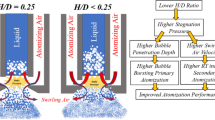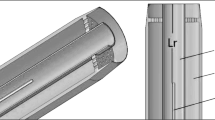Abstract
An improved, second-generation aerosol shock tube (AST II) has been developed for the study of the chemical kinetics of low-vapor-pressure fuels. These improvements enable a wider range of fuel concentrations and enhanced spatial uniformity relative to our initial aerosol shock tube (AST I). In addition, the design of AST II limits the aerosol loading zone in the shock tube to a fixed region (1.2 m in length adjacent to the shock tube endwall). AST II achieves these improvements using a separate holding tank to prepare the aerosol mixture and a slightly under-pressure dump tank to carefully pull the aerosol mixture into the tube in a plug-flow. This filling method is capable of producing room temperature test gas mixtures of n-dodecane with equivalence ratios of up to 3.0 in 21 % O2, three times the loading achievable in the earlier AST I that used a flow-through strategy. Improvements in aerosol uniformity were quantified by measuring the liquid volume concentration at multiple locations in the shock tube. The measurements made over a length of 1.1 m of shock tube indicate that the AST II method of filling produces non-uniformities in liquid volume concentration of less than 2 %, whereas in the AST I method of filling the non-uniformities reached 16 %. The improved uniformity can also be seen in measurement of gas-phase fuel concentration behind the incident shock wave after the liquid droplets have evaporated. Significant reduction in the scatter of ignition delay times measured using AST II have also been achieved, confirming the importance of uniform loading of the aerosol in making high-quality combustion measurements.
Similar content being viewed by others
References
Davidson D.F., Haylett D.R., Hanson R.K.: Development of an aerosol shock tube for kinetic studies of low-vapor-pressure fuels. Combust. Flame 155(1–2), 108–117 (2008)
Haylett D.R., Lappas P.P., Davidson D.F., Hanson R.K.: Application of an aerosol shock tube to the measurement of diesel ignition delay times. Proc. Combust. Inst. 32, 477–484 (2009)
Roth P.: The shock tube technique applied to study aerosol rate processes. Shock Waves 1, 73–82 (1991)
Cadman P.: Shock tube combustion of liquid hydrocarbon sprays of toluene. Phys. Chem. Chem. Phys. 3, 4301–4309 (2001)
Rotavera, B., Amadio, A., Antonovski, V., Petersen, E.: New approaches for fundamental rocket injector studies using a shock tube. In: 42nd AIAA/ASME/SAE/ASEE Joint Propulsion Conference & Exhibit, 9–12 July 2006
Petersen E.L., Rickard M.J.A., Crofton M.W., Abbey E.D., Traum M.J., Kalitan D.M.: A facility for gas- and condensed-phase measurements behind shock waves. Meas. Sci. Technol. 16, 1716–1729 (2005)
Servaites J., Krier H., Melcher J.C., Burton R.L.: Ignition and combustion of aluminum particles in shocked H2O/O2/Ar and CO2/O2/Ar mixtures. Combust. Flame 125(1–2), 1040–1054 (2001)
Bazyn T., Glumac N., Krier H., Ward T.S., Schoenitz M., Dreizin E.L.: Reflected shock ignition and combustion of aluminum and nanocomposite thermite powders. Combust. Sci. Technol. 179(3), 457–476 (2007)
Glumac N., Krier H., Bazyn T., Eyer R.: Temperature measurements of aluminum particles burning in carbon dioxide. Combust. Sci. Technol. 177(3), 485–511 (2005)
Kalitan, D.M., Petersen, E.L.: A shock-tube study of aluminum oxidation at elevated temperatures. In: 42nd AIAA/ASME/SAE/ASEE Joint Propulsion Conference & Exhibit, 9–12 July 2006
Falk T.J.: Evaporation of submicron platinum particles in a shock tube. J. Chem. Phys. 48, 3305 (1968)
Davidson D.F., Hanson R.K.: Interpreting shock tube ignition data. Int. J. Chem. Kinet. 36(9), 510–523 (2004)
Vasu S.S., Davidson D.F., Hong Z., Vasudevan V., Hanson R.K.: n-Dodecane oxidation at high-pressures: measurements of ignition delay times and OH concentration time-histories. Proc. Combust. Inst. 32(1), 173–180 (2009)
Inhalation Toxicology Research Institute Annual Report 1995–1996: ITRI-148, prepared for the U.S. Department of Energy under Contract DE AC04 76EV01013, Albuquerque, NM, December 1996
Brown, J.R.: Low-speed, low-cost wind tunnel. The Engineer, 481–483. 31 March 1967
Bae G.-N., Kinney P.D., Liu B.Y.H., Pui D.Y.H.: Investigation of aerosol spatial distributions downstream of a critical orifice at low pressure. Aerosol Sci. Technol. 28(6), 479–488 (1998)
Sato S., Chen D.-R., Pui D.Y.H.: A novel method for producing spatially uniform aerosols in a low pressure environment. Aerosol Sci. Technol. 36(2), 145–153 (2002)
Hanson, T.C.: The development of a facility and diagnostics for studying shock-induced behavior in micron-sized aerosols. Stanford Thesis, Dec 2005
van de Hulst H.C.: Light Scattering by Small Particles. Wiley, New York (1957)
Ren W., Jeffries J., Hanson R.: Temperature sensing in shock-heated evaporating aerosol using wavelength-modulation absorption spectroscopy of CO2 near 2.7 μm. Meas. Sci. Technol. 21, 105603 (2010)
Sirjean, B., Dames, E., Sheen, D.A., You, X.-Q., Sung, C., Holley, A.T., Egolfopoulos, F.N., Wang, H., Vasu, S.S., Davidson, D.F., Hanson, R.K., Pitsch, H., Bowman, C.T., Kelley, A., Law, C.K., Tsang, W., Cernansky, N.P., Miller, D.L., Violi, A., Lindstedt, R.P.: A high-temperature chemical kinetic model of n-alkane oxidation. JetSurF version 1.0, September 15, 2009. http://melchior.usc.edu/JetSurF/Version1_0/Index.html
Author information
Authors and Affiliations
Corresponding author
Additional information
Communicated by K. Takayama.
Rights and permissions
About this article
Cite this article
Haylett, D.R., Davidson, D.F. & Hanson, R.K. Second-generation aerosol shock tube: an improved design. Shock Waves 22, 483–493 (2012). https://doi.org/10.1007/s00193-012-0383-x
Received:
Revised:
Accepted:
Published:
Issue Date:
DOI: https://doi.org/10.1007/s00193-012-0383-x




